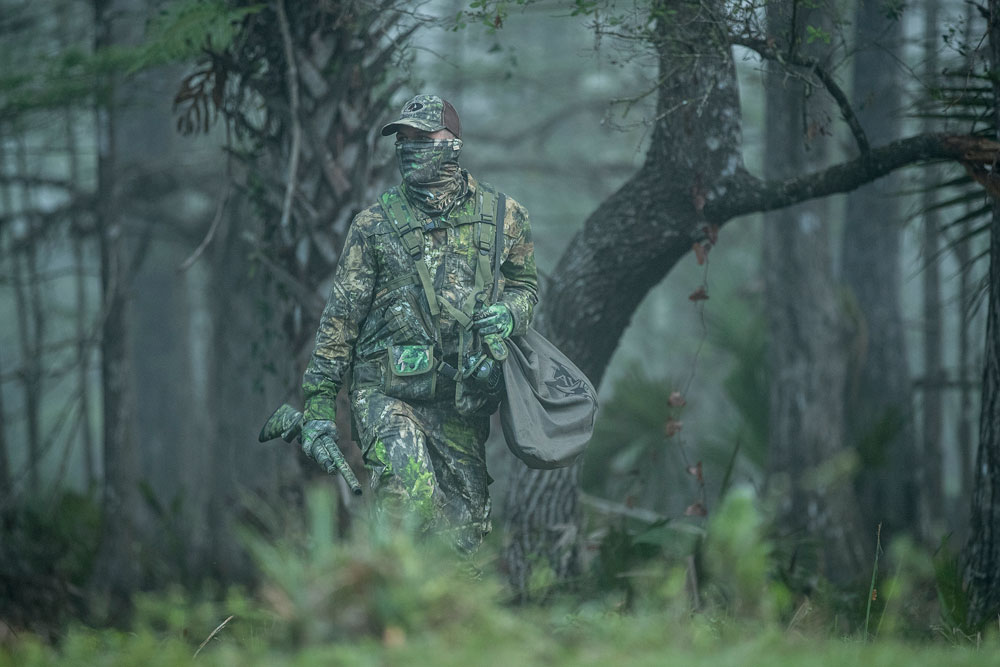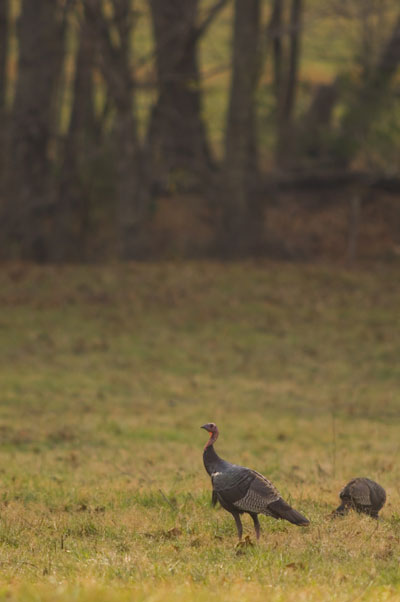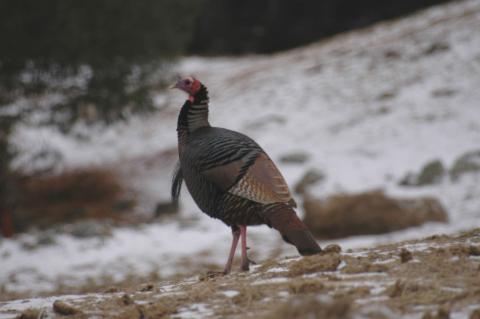Scott Ellis

Hunting turkeys late in the season can present numerous difficulties, yet can be very productive. We will discuss my most successful tactics. There are a few variables that need to be identified to help decide your plan of attack. Once you have done so, put your strategy in place and throw your hail Mary.
Breeding Cycle
Understanding a little about the biology of a wild turkey can help aid in your overall hunting success. Identifying where the birds are in their spring breeding can dictate your applied strategies. This can be deduced by simply paying attention to their behavior throughout your day in the woods. Generally, two scenarios will present themselves late in the season. One is the hens are nesting or two, they are still with the hens and actively breeding. The hen’s nesting presents the best case scenario for doing some serious late season damage to the gobbler population. If they are still henned up it can present some of the toughest hunting you’ll face.
Now let’s take a look at how to identify where the turkeys are in this breeding cycle. How do you know if the hens are nesting? The first and most obvious indicator is simply seeing numerous single hens alone during all parts of the day. This signifies that they have left the gobblers and are occupying a nest nearby. Another notable identifier is that the gobbling frequency increases dramatically in the mornings and throughout the day. Gobblers are still in the mood for love but have no female companions so they are very vocal and attempting to locate hens that have not been bred. If you’re not able to lay eyes on the birds, simply look for tracks. Numerous single hen or lone gobbler tracks should tell you that the hens are on their own taking care of either the laying or incubating process.
If gobblers are still actively breeding the hens you will generally hear good gobbling on the roost and they will go silent after fly down. As well, if you’re able to spot the turkeys in the woods you are hunting, it is simple. You will notice gobblers hanging with hens throughout the entire day.
Hunting Pressure
 Whether hunting private or public land late in the season, it’s a pretty safe bet the birds have been hunted to some degree. Hunting pressured, late season birds is a challenge but success can be in your future. Approach any turkey late in the season as if they have been shot at, called in and “spooked” or any other pressure related scenario. Use even more care and caution with each set up and your overall presence in the woods. Walk slower and quieter. Conceal yourself even better than before. I believe once turkeys have had consistent human contact, especially when called to, they will raise their already overly cautious tendencies. Add as much realism to your calling sequences as possible and do not overcall. When hunting pressured areas not only will the gobbling activity sometimes decrease, the amount of hen talk will as well. It is very common for gobblers to sneak into gun range never uttering a sound. Keep your guard up and make slow gradual movements when scanning for your bird.
Whether hunting private or public land late in the season, it’s a pretty safe bet the birds have been hunted to some degree. Hunting pressured, late season birds is a challenge but success can be in your future. Approach any turkey late in the season as if they have been shot at, called in and “spooked” or any other pressure related scenario. Use even more care and caution with each set up and your overall presence in the woods. Walk slower and quieter. Conceal yourself even better than before. I believe once turkeys have had consistent human contact, especially when called to, they will raise their already overly cautious tendencies. Add as much realism to your calling sequences as possible and do not overcall. When hunting pressured areas not only will the gobbling activity sometimes decrease, the amount of hen talk will as well. It is very common for gobblers to sneak into gun range never uttering a sound. Keep your guard up and make slow gradual movements when scanning for your bird.
Calling Sequences/Setups
Once you have identified the breeding cycle and the degree of hunting pressure the birds have received, you can start putting together your strategy. Calling sequences are a critical factor in late season success. If you have the luxury of a gobbling bird, do not ruin the opportunity by becoming overzealous with your calling. Always start the conversation very softly. Call very sparingly, only increasing frequency and excitement level if absolutely needed. If clucking, purring and soft yelping has him coming in to your setup, then never do anymore. Keep delivering the soft, sweet, love to him. If it takes a little more excited yelping to pique his interest then try it. Bear in mind, once he starts toward you do not constantly call to him. Let him look for you. Use patience and restraint as your two key factors for success. If he gets to 75-100 yards and stops gobbling, be still and keep your eyes peeled. There’s a very good possibility he is coming in quiet.
If you’re not hearing any gobbling, but hunting in an area you know holds turkeys, blind calling and patience are your two best friends. You could be encountering pressured gobblers that are just not being vocal or the gobblers in the area could have hens. Regardless, set up and conceal yourself well. Again stay on the soft side of the calling spectrum. Giving soft 4-6 note yelps every 15 minutes or so. Fill in the time between the yelping sequences with clucking and purring, but also incorporate the age old “scratching in the leaves” technique. I will also add another degree of realism by giving soft kee kees and low volume lost yelps. This calling is capitalizing on turkeys’ curious and gregarious nature. The kees and lost yelping could strike a nerve with gobblers’ hens, bringing the whole flock into gun range. Remember, this is not something you repeat over and over. Use it 2-3 times an hour and keep the volume low.
Keep in mind that there is a strong possibility the gobbler will show up without making a sound. Listen for approaching footsteps or spitting and drumming. Keep your alert level high. You do not want to ruin a last minute chance at a long beard because you’re fidgeting.



























